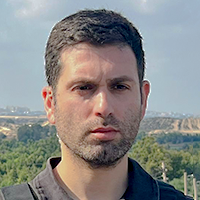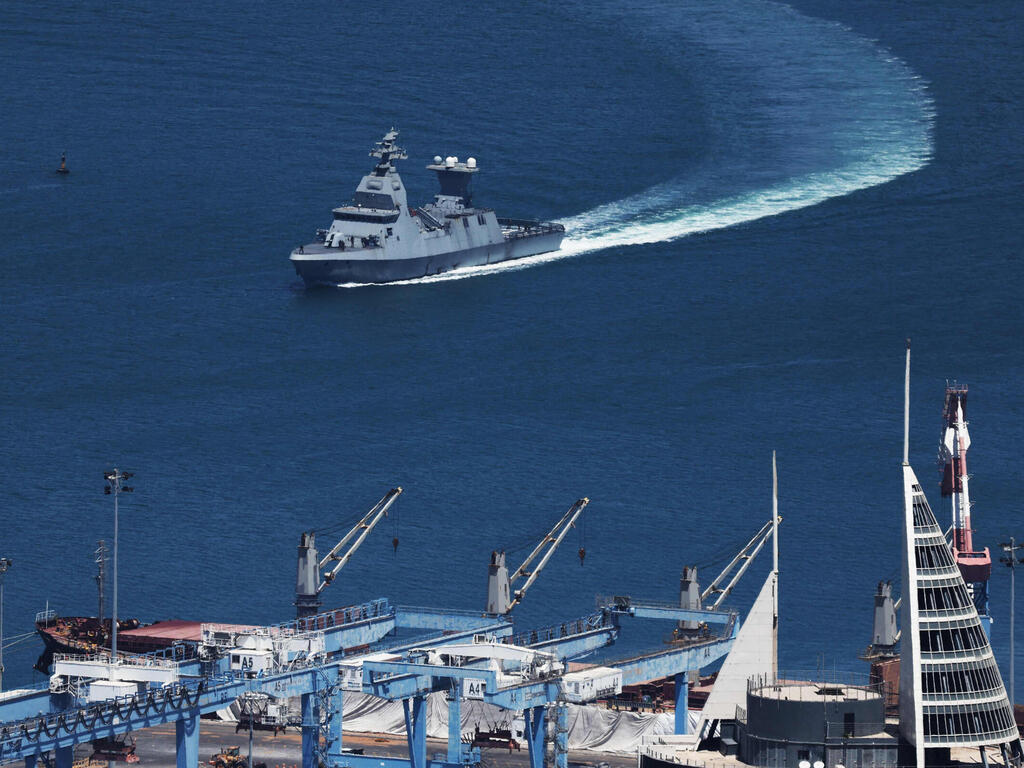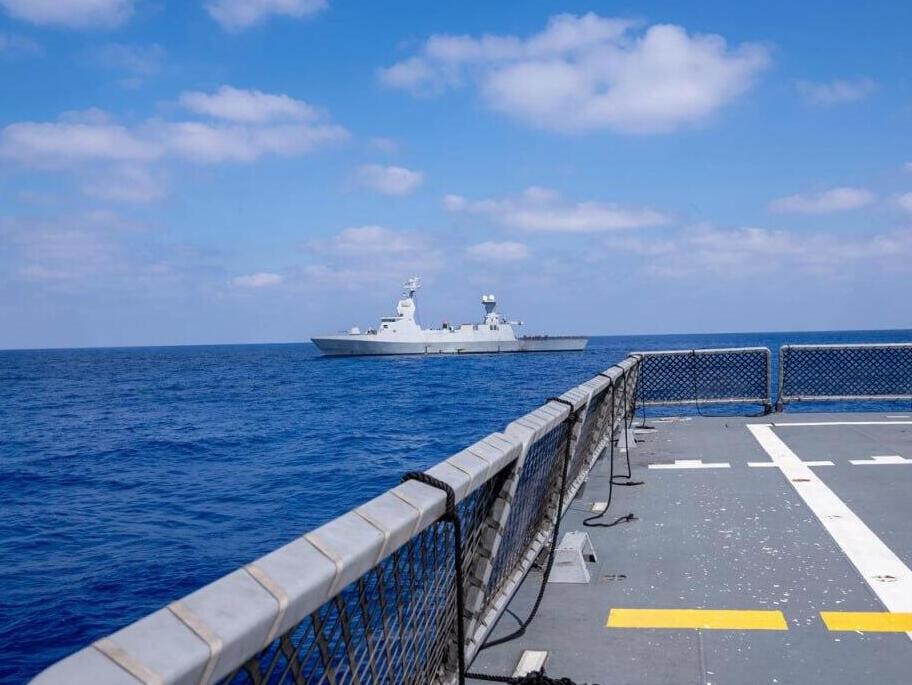Thousands of kilometers separate the Israeli Navy’s missile ships, requiring Flotilla 3 Commander Col. A. to simultaneously hold a satellite communication device with one hand while speaking with a patrol crew near Syria with the other. As the Israeli military establishes five new outposts along the Lebanese border, the navy is tightening its grip on Hezbollah from the west, operating with full freedom to surveil, observe, and strike.
In recent months, Israeli Navy vessels have played a central role in the military’s enforcement strikes in Lebanon, targeting Hezbollah infrastructure and operatives with precision fire from formidable Sa’ar 6-class corvettes. Weighing 2,000 tons, these are the navy’s largest and most advanced ships.
During a special operation in September to destroy an underground missile production site in Masyaf, Syria, the missile boat flotilla played a key role in clearing the way and providing remote cover for Israeli Air Force units. Throughout the sensitive operation, the ships launched attacks deep inside Syria from distances of over 100 kilometers, securing safe passage for Israeli commando forces.
Since the October 7 massacre, the Navy’s operational scope has quadrupled. It has intercepted dozens of attempts to target Israel’s offshore gas rigs with drones and missiles launched from Syria, Lebanon, and Iraq. Additionally, it has carried out daily strikes in support of ground forces in Gaza, launched hundreds of attacks against Hezbollah, and even neutralized 15 Syrian naval vessels while crippling military ports in Tartus and Latakia.
Get the Ynetnews app on your smartphone: Google Play: https://bit.ly/4eJ37pE | Apple App Store: https://bit.ly/3ZL7iNv
It has also been engaged in countering the Houthi threat from Yemen, an ongoing challenge for Israel. Amid the fighting, the navy successfully integrated four new German-made corvettes into operational service. Looking ahead, it is preparing to receive Reshef-class ships, recently approved for production, which will replace aging Sa’ar 4.5-class vessels in about two years.
Patrolling the Lebanese Front
The Lebanese town of Naqoura, located in the western sector near the Israeli border, is hidden from view due to the region’s topography. However, its buildings are clearly visible from navy missile ships patrolling kilometers offshore. Recently, Israeli forces from the 146th Division withdrew from the area as the Lebanese army moved south. These troops remain under constant naval cover, even in deeper inland areas with no direct line of sight.
“We’ve hit reset with Hezbollah, collecting new intelligence and refreshing our target database, even from the sea,” Col. A. told Ynet and Yedioth Ahronoth.
One of the navy’s newest missile ships, the INS Nitzachon, stands six stories tall. Throughout the war, all types of missile boat weaponry have been deployed, including the cutting-edge and highly expensive ALRAD missiles, which cost tens of millions of shekels per unit.
“One of our greatest achievements in this war has been protecting Israel’s energy independence,” said Col. A. “Gas production from offshore rigs never stopped. Had they been hit, Israel would have experienced widespread power outages.”
He noted that unlike the 2006 Lebanon War, cargo shipments to Haifa continued uninterrupted. “That’s not something to take for granted. Hezbollah has significantly upgraded its arsenal since 2006, but our missile boats are executing both powerful defenses and lethal offensives simultaneously.”
A Stealthy Naval Force
The missile ships’ weaponry remains mostly concealed. These vessels feature stealth technology that reduces their radar signature, making them appear lightly armed at first glance, with only a 76mm cannon up front and two missile batteries at the rear. However, the ships were designed by German engineers to hide their advanced weaponry, including special Iron Dome launchers, inside the hull, revealing them only during launch sequences. This stealth capability helps evade enemy radar detection.
INS Nitzachon also employs state-of-the-art electronic warfare systems, with a powerful 360-degree radar that remains stationary, unlike older rotating models, and can detect launches as far away as Turkey.
“Our ship is like a microcosm of the air force, equipped with an air control unit, Iron Dome, and deadly weaponry, all at sea,” the flotilla commander explained.
Inside the ship’s Combat Information Center, dimly lit screens flicker with orange, green, and red indicators. The room is divided into three sections—detection, defense, and offense—where 19- and 20-year-old female operators monitor the battlespace. In contrast, similar positions in Western navies, such as in France or the United States, are typically manned by seasoned personnel in their 30s or 40s.
“When a shift commander steps down from the bridge, their eyes take a minute or two to adjust to the light or darkness. That’s a long time in combat,” Col. A. explained. The ship’s exercises highlight just how crowded the skies and waters of the Mediterranean have become. If an unidentified airborne target suddenly appears, operators must first classify it, confirm its identity, and then determine the best response—whether to engage from their own ship, another naval vessel, or rely on air force or missile defense systems.
“In one operation, we were launching strikes on a key Hezbollah asset when a hostile drone suddenly appeared,” a crew member recalled. “One section of the combat center focused on intercepting the drone, while another continued the attack—both simultaneously, without pausing.”
The Battle at Sea
During the war, Israeli naval forces even intercepted drones launched from Yemen under surreal circumstances. “We were in the Red Sea, hearing party music from hotels in Eilat, watching fireworks and celebrations in the distance—while at the same time, we knew a drone was en route. But we intercepted it far from Israeli shores, ensuring safety without disruption,” a sailor recounted.
Despite the relative calm following the ceasefire, vigilance remains high. For Col. A. and his subordinates, a Hezbollah coastal missile launch is a constant threat.
The commander recalled a mission two months ago when his unit obliterated the Syrian navy. “We reached just a few kilometers from the Syrian coast and watched their ships sink as their ports burned. When we returned to Haifa, Navy Chief Vice Adm. David Saar Salama was waiting on the dock. He congratulated us and immediately ordered us back out to protect the gas rigs.”
INS Nitzachon is also led by Deputy Commander Maj. A., and soon, the Israeli Navy is set to appoint its first-ever female missile boat commander. The navy is preparing to integrate more female combatants, not only in officer roles but also on the upcoming Reshef-class ships.
“They’re the backbone of the ship—brilliant and exceptional,” said Col. A. “At the height of the war, we had an entire armada at sea, with over 1,000 navy personnel operating simultaneously, from Syria to the Red Sea.”





